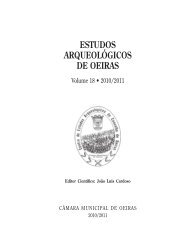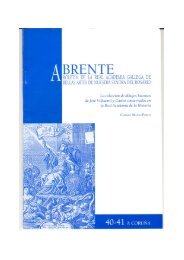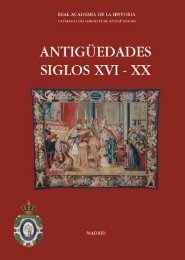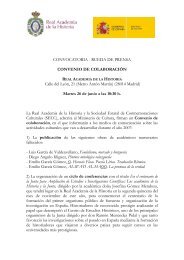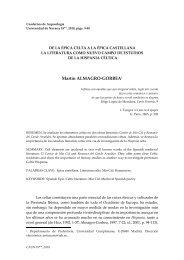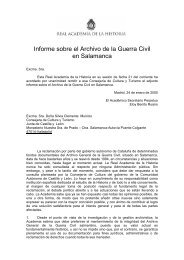GH24 CUBIERTA 2, page 1 @ Normalize - Real Academia de la ...
GH24 CUBIERTA 2, page 1 @ Normalize - Real Academia de la ...
GH24 CUBIERTA 2, page 1 @ Normalize - Real Academia de la ...
You also want an ePaper? Increase the reach of your titles
YUMPU automatically turns print PDFs into web optimized ePapers that Google loves.
La fotografía en <strong>la</strong> Arqueología Españo<strong>la</strong><br />
Santo Sepulcro <strong>de</strong> Jerusalén, un edificio que, fotografiado también por De Prangey, entre otros, constituye<br />
un ejemplo <strong>de</strong> cómo los viajeros-fotógrafos mostraron un interés recurrente por ciertos edificios<br />
que se repitieron en casi todos los viajes <strong>de</strong> <strong>la</strong> época.<br />
Otro <strong>de</strong> los viajeros que incorporó <strong>de</strong> manera notable el uso <strong>de</strong> <strong>la</strong> fotografía fue el cirujano escocés<br />
R. MacPherson. Insta<strong>la</strong>do en Roma en 1840 con <strong>la</strong> finalidad <strong>de</strong> estudiar pintura, recibió en 1851<br />
<strong>la</strong> visita <strong>de</strong> un amigo <strong>de</strong> Edimburgo, C<strong>la</strong>rk, con un aparato fotográfico, iniciándose así en el aprendizaje<br />
<strong>de</strong> <strong>la</strong> fotografía (VVAA., 1999, 26). Durante los veinte años siguientes, MacPherson realizó numerosos<br />
estudios <strong>de</strong> edificios romanos y <strong>de</strong> <strong>la</strong> ciudad. Sus vistas se vendieron a los crecientes viajeros y se<br />
encuentran en muchas <strong>de</strong> <strong>la</strong>s bibliotecas y centros <strong>de</strong> estudio europeos. Han sido incluso catalogadas<br />
como <strong>la</strong>s representaciones arquitectónicas más <strong>de</strong>stacables <strong>de</strong>l XIX (VVAA., 1999, 26).<br />
Uno <strong>de</strong> los fotógrafos más conocidos en <strong>la</strong> Ing<strong>la</strong>terra <strong>de</strong>l siglo XIX y que más contribuyó a <strong>la</strong> difusión<br />
<strong>de</strong> una <strong>de</strong>terminada visión <strong>de</strong> Egipto fue Francis Frith (Van Haaften, 1980). Aunque se inició<br />
en <strong>la</strong> fotografía en 1850 no fue hasta 1856 cuando realizó sus tomas <strong>de</strong> Egipto, cuando sus editores<br />
Negretti y Zambra, le contrataron para cubrir el área <strong>de</strong>s<strong>de</strong> el Cairo hacia el este 81 (Nir, 1985, 66). Sus<br />
objetivos y consi<strong>de</strong>ración <strong>de</strong> <strong>la</strong> fotografía se ponían <strong>de</strong> manifiesto en <strong>la</strong> introducción <strong>de</strong> su obra Egypt<br />
and Palestine, don<strong>de</strong> Frith <strong>de</strong>c<strong>la</strong>raba:<br />
144<br />
“Sa<strong>la</strong>am!– Peace be with thee, oh, thou pleasant buyer of my book.<br />
It is my intention, should my life be spared, and should the present un<strong>de</strong>rtaking prove successful,<br />
to present to the public, from time to time, my impressions of foreign <strong>la</strong>nds, illustrated by<br />
photographic views.<br />
I have chosen as a beginning of my <strong>la</strong>bours, tho two most interesting <strong>la</strong>nds of the globe<br />
Egypt and Palestine. Were but the character of the Pen we scarcely expect from a traveller “the<br />
truth, the whole truth, and nothing but the truth”. I am all too <strong>de</strong>eply enamoured of the gorgeous,<br />
sunny East, to feign that my insipid, colourless pictures are by no means just to their spiritual<br />
charms. But, in<strong>de</strong>ed, I hold it to be impossible, by any means, fully and truthfully to inform the<br />
mind of scenes which are wholly foreign to the eye. There is no effectual substitute for actual travel;<br />
but it is my ambition to provi<strong>de</strong> for those to whom circunstamces forbid that luxury, faithful<br />
representations of the scenes I have witnessed and I shall en<strong>de</strong>avor to make the simple truthfulness<br />
of the Camera a gui<strong>de</strong> for my Pen 82 ” (Nir, 1985, 61).<br />
Con esta <strong>de</strong>c<strong>la</strong>ración <strong>de</strong> intenciones, Frith l<strong>la</strong>maba <strong>la</strong> atención <strong>de</strong>l comprador victoriano burgués<br />
y el armchair traveller <strong>de</strong>l salón victoriano. Dec<strong>la</strong>rando <strong>de</strong> esa forma quiénes serían los principales compradores<br />
<strong>de</strong> su obra, observamos, sin embargo, una cierta diversificación <strong>de</strong> sus productos. Frith utilizó,<br />
en efecto, varias cámaras y formatos durante esta expedición. Utilizó simultáneamente una cámara<br />
<strong>de</strong> estudio que usaba p<strong>la</strong>cas <strong>de</strong> cristal <strong>de</strong> 8x10, otra cámara <strong>de</strong> dos objetivos para obtener fotografías estereoscópicas<br />
que pudiesen ser visionadas en tres dimensiones, y una tercera para negativos <strong>de</strong> p<strong>la</strong>cas<br />
<strong>de</strong> cristal <strong>de</strong> mayor tamaño.<br />
La toma <strong>de</strong> estas fotografías estuvo ro<strong>de</strong>ada <strong>de</strong> gran<strong>de</strong>s dificulta<strong>de</strong>s. Frith no sólo tenía que transportar<br />
estas pesadas cámaras en bote, mu<strong>la</strong>s y dromedarios, sino que el equipo <strong>de</strong>l fotógrafo incluía<br />
también un cuarto oscuro (Jay, 1973, 22). Incluso disponemos <strong>de</strong> algún testimonio suyo refiriéndose<br />
a estas dificulta<strong>de</strong>s: “I have often thought, when manoeuvring about a position for my camera, of the<br />
exc<strong>la</strong>mation of the great mechanist of antiquity: “give me a fulcrum for my lever, and I will move the<br />
world”. Oh, what pictures we would make, if we could command our points of view” (Jay, 1973, 24).<br />
Sin embargo, y a pesar <strong>de</strong> <strong>la</strong>s incomodida<strong>de</strong>s <strong>de</strong>l trabajo con el colodión húmedo, los resultados<br />
<strong>de</strong> Frith fueron excelentes. A pesar <strong>de</strong> los problemas que conllevaba <strong>la</strong> práctica fotográfica <strong>de</strong> <strong>la</strong> época,<br />
encontramos pocos fallos en sus fotografías. Incluso constatamos un a<strong>de</strong>cuado uso <strong>de</strong> <strong>la</strong> bril<strong>la</strong>nte luz<br />
81 Conocemos re<strong>la</strong>tivamente bien el trabajo <strong>de</strong> F. Frith. Ver, por ejemplo, JAY (1973).<br />
82 FRITH, F., 1859: Egypt and Palestine, Londres.




